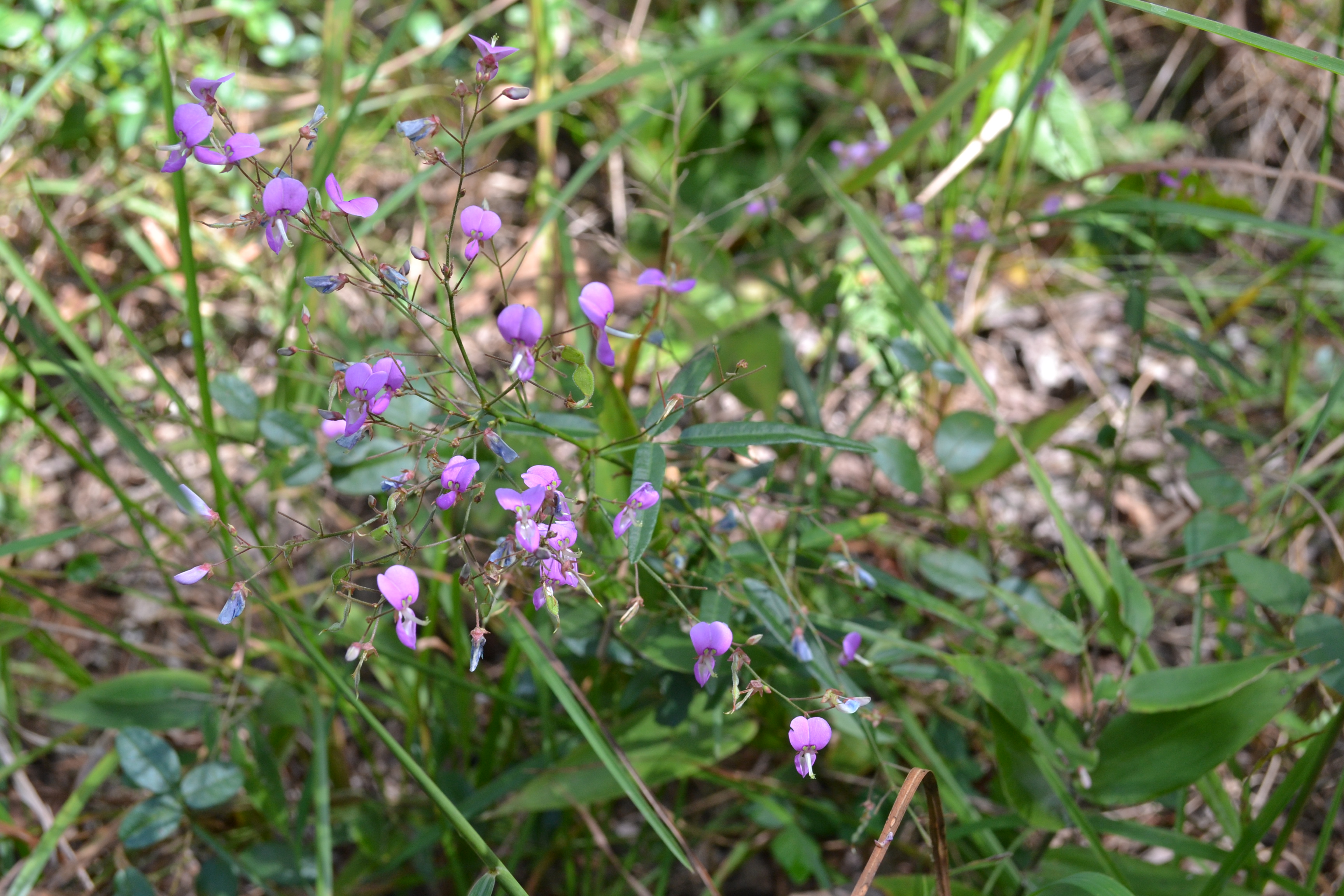Difference between revisions of "Desmodium paniculatum"
(→Distribution) |
|||
| Line 34: | Line 34: | ||
===Phenology=== <!--Timing off flowering, fruiting, seed dispersal, and environmental triggers. Cite PanFlora website if appropriate: http://www.gilnelson.com/PanFlora/ --> | ===Phenology=== <!--Timing off flowering, fruiting, seed dispersal, and environmental triggers. Cite PanFlora website if appropriate: http://www.gilnelson.com/PanFlora/ --> | ||
| − | ''D. paniculatum'' flowers between July and November, peaking in September<ref name="Weakley 2015"/><ref>Nelson G. (11 December 2017) PanFlora. Retrieved from gilnelson.com/PanFlora/</ref> with conspicuous purple colored flowers.<ref name="Ladybird"/> Flowering can be delayed and seed production reduced when grown in high densities where competition is prevalent.<ref name="Wulff 1986c">Wulff R. D. (1986). Seed size variation in ''Desmodium paniculatum'': III. Effects on reproductive yield and competitive ability. Journal of Ecology 74(1):115-121.</ref> | + | ''D. paniculatum'' flowers between July and November, peaking in September<ref name="Weakley 2015"/><ref>Nelson G. (11 December 2017) PanFlora. Retrieved from gilnelson.com/PanFlora/</ref> with conspicuous purple colored flowers.<ref name="Ladybird"/> Flowering can be delayed and seed production reduced when grown in high densities where competition is prevalent.<ref name="Wulff 1986c">Wulff R. D. (1986). Seed size variation in ''Desmodium paniculatum'': III. Effects on reproductive yield and competitive ability. Journal of Ecology 74(1):115-121.</ref> Seed weights vary by a factor of about 4 due to difference in several interacting variables including nutrient intake, water availability, photoperiod, temperature, and grazing impact.<ref name="Wulff 1986a">Wulff R. D. (1986). Seed size variation in ''Desmodium paniculatum'': I. Factors affecting seed size. Journal of Ecology 74(1):87-97.</ref> |
| − | |||
<!--===Seed dispersal===--> | <!--===Seed dispersal===--> | ||
Revision as of 16:18, 11 December 2017
| Desmodium paniculatum | |
|---|---|

| |
| Photo by Kevin Robertson | |
| Scientific classification | |
| Kingdom: | Plantae |
| Division: | Magnoliophyta - Flowering plants |
| Class: | Magnoliopsida - Dicots |
| Order: | Fabales |
| Family: | Fabaceae |
| Genus: | Desmodium |
| Species: | D. paniculatum |
| Binomial name | |
| Desmodium paniculatum L. | |

| |
| Natural range of Desmodium paniculatum from USDA NRCS Plants Database. | |
Common Name(s): panicledleaf ticktrefoil;[1] panicled tick trefoil[2]
Contents
Taxonomic Notes
Varieties: D. paniculatum var. paniculatum; D. paniculatum var. epetiolatum[1][3]
Description
Desmodium paniculatum is a facultative upland dioecious perennial forb/herb.[1] It requires partial shade, uses low amounts of water, and inhabits dry clay and loamy soils.[2]
Distribution
Desmodium paniculatum can be found from Texas to Nebraska, eastward to Florida, the Carolina's, and Pennsylvania, and northward into Michigan, New York, Maine and parts of eastern Canada.[1]
Ecology
Habitat
D. paniculatum is found in pine savannas, flatwoods, bogs, fields, woodland borders, and disturbed areas.[3]
Phenology
D. paniculatum flowers between July and November, peaking in September[3][4] with conspicuous purple colored flowers.[2] Flowering can be delayed and seed production reduced when grown in high densities where competition is prevalent.[5] Seed weights vary by a factor of about 4 due to difference in several interacting variables including nutrient intake, water availability, photoperiod, temperature, and grazing impact.[6]
Seed bank and germination
Larger seeds of D. paniculatum have a higher rate of germination than smaller seeds.[7]
Use by animals
D. paniculatum produces seeds which attract birds and small rodents, including upland game birds such as bobwhite quail and wild turkey and rodents such as the white-footed mouse and deer mouse. It also serves as a source of food for cottontail rabbits, livestock, and other hoofed mammalian herbivores including white tailed deer.[8]
Conservation and Management
Cultivation and restoration
Photo Gallery
References and notes
- ↑ 1.0 1.1 1.2 1.3 USDA, NRCS. (2016). The PLANTS Database (http://plants.usda.gov, 30 November 2017). National Plant Data Team, Greensboro, NC 27401-4901 USA.
- ↑ 2.0 2.1 2.2 Plant database: Rubus cunifolius. (12 December 2017).Lady Bird Johnson Wildflower Center. URL: https://www.wildflower.org/plants/result.php?id_plant=DEPA6
- ↑ 3.0 3.1 3.2 Weakley A. S.(2015). Flora of the Southern and Mid-Atlantic States. Chapel Hill, NC: University of North Carolina Herbarium.
- ↑ Nelson G. (11 December 2017) PanFlora. Retrieved from gilnelson.com/PanFlora/
- ↑ Wulff R. D. (1986). Seed size variation in Desmodium paniculatum: III. Effects on reproductive yield and competitive ability. Journal of Ecology 74(1):115-121.
- ↑ Wulff R. D. (1986). Seed size variation in Desmodium paniculatum: I. Factors affecting seed size. Journal of Ecology 74(1):87-97.
- ↑ Wulff R. D. (1986). Seed size variation in Desmodium paniculatum: II. Effects on seedling growth and physiological performance. Journal of Ecology 74(1):99-114.
- ↑ Leif J. and Belt S. (2013). Plant Guide for Panicledleaf ticktrefoil (Desmodium paniculatum), USDA-Natural Resources Conservation Service, Rose Lake Plant Materials Center, East Lansing, Michigan, 48823 and USDA-Natural Resources Conservation Service Norman Berg National Plant Materials Center, Beltsville, Maryland, 20705.